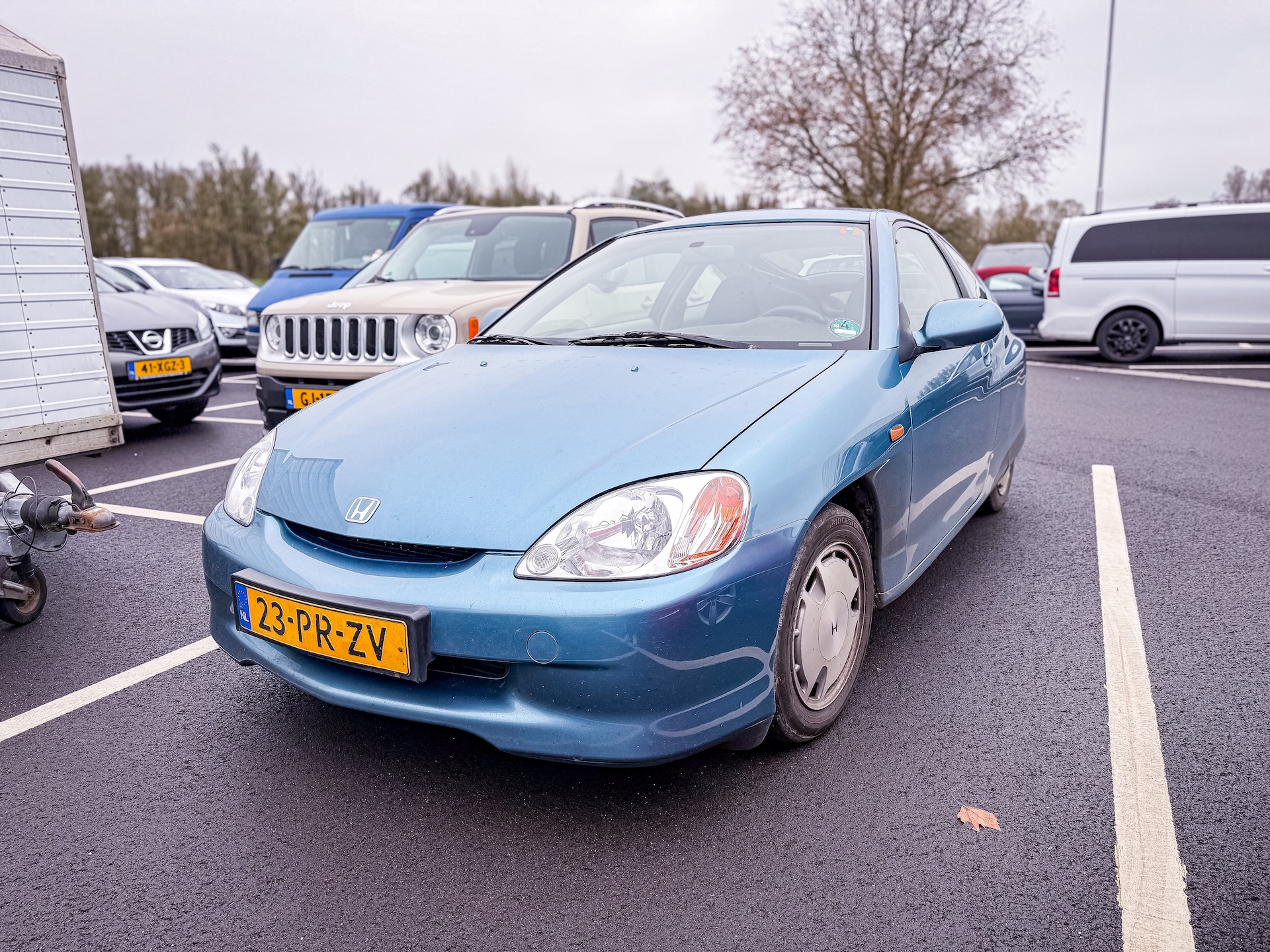Spotted: the first generation Honda Insight
Hyper-aerodynamic, such a Honda Insight
Futuristic, hyper-aerodynamic and so economical you could almost drive it for free. The Insight was Honda’s technical calling card: a laboratory on wheels that you could just take to the supermarket.
Drop shape
The Insight was not a car conceived in a design studio to stand out. The design literally came out of the wind tunnel. The engineers started with a teardrop profile, the droplet shape considered ideal in aerodynamics, and built the car around that. The result was an extremely narrow body, a flat bottom and a roofline that sloped gradually toward the rear, as if the car were being permanently smoothed by a gentle breeze. Then there were the rear wheel arches, which were completely closed. Honda did this not to create idiosyncratic shapes, but purely to get airflow tighter along the car. After all, rear wheels cause turbulence; you lose precious energy with them. By placing those panels, Honda managed to reduce the drag coefficient to 0.25, a value that many modern cars still fail to achieve. It looked strange, but technically it was brilliant.

1.0-liter three-cylinder gasoline engine
Underneath that unusual exterior was just as interesting a construction. The body was made entirely of aluminum. Not as a luxury statement, but because every kilogram counted. Lighter meant more economical, and more economical meant fewer emissions. Honda therefore worked with a 1.0-liter three-cylinder gasoline engine, a remarkably small engine that produced about 54 kW (74 hp). But the real magic was in the IMA system – Integrated Motor Assist – in which a compact electric motor helped the gasoline engine during acceleration and recovered energy during deceleration.
Unlike the Prius, the Insight was not a full hybrid, but what we would now call a mild hybrid. It could not drive fully electric, but the electric assistance provided a small but effective boost just at the moments when you consume the most. The system power thus came to 62 kW (84 hp). That doesn’t sound impressive, but the car weighed less than 850 kilograms. As a result, it felt livelier in practice than the figures suggest.
Engineering Honda Insight Gen1
Beneath the aluminum bodywork was Honda’s first-generation IMA (Integrated Motor Assist) system. The powertrain consisted of a:
1.0-liter three-cylinder gasoline engine (LEA):
995 cc – 56 kW (74 hp) – 91 Nm
Electric motor:
10 kW (13 hp) – 36 Nm
System power:
62 kW (84 hp)
838 to 852 kilograms
It was not a rocket, but it weighed only 838 to 852 kilograms. By comparison, a Toyota Prius of the time was over 300 kilograms heavier. Honda’s IMA system was mild hybrid avant la lettre. The electric motor helped mainly when accelerating and acted as a generator when decelerating. Full electric driving was not possible, but it was economical.
Kind of meditative driving experience
Those who drove an Insight at the time quickly noticed that the car evoked a kind of meditative driving experience. The instrument cluster showed your consumption in real time. Every small movement of your right foot caused a reaction in the display. You were challenged to drive as economically as possible: accelerate calmly, anticipate early, make smart use of the electric motor. As a result, many drivers unconsciously started hypermiling, even before that word became popular. The factory specification of more than 1 on 33 was difficult to achieve under normal conditions, but 1 on 25 to 30 was surprisingly realistic for those who tried a little. Then there were the fanatics who achieved 1:40, often in the United States, where the Insight became an icon among efficiency drivers.

One big problem
But as brilliant as its engineering was, the Insight had one major problem: It was too extreme for the mass market. Whereas the Prius had five seats, a conventional look and a solid marketing campaign, the Insight offered only two seats, a trunk in the back and an eccentric design that just had to suit you. Especially in a country like the Netherlands, where practicality is often more important than technical elegance, this was a challenge. As a result, Honda only managed to sell seventeen of them in the Netherlands. As a result, you almost never see the car here, except when an enthusiast gets one from abroad. The American market was much more receptive to the Insight, especially among technology enthusiasts and eco-enthusiasts who saw the car as one of the purest efficiency machines ever built.
Symbol of thrift
Basically, the Insight was intended primarily as a symbol: a demonstration of what could be achieved with smart technology and a different way of thinking. Honda wanted to prove that without giant battery packs and without complex hybrid architectures, you could already make huge strides in consumption and emissions. It was an exercise in reduction: anything not needed had to go. Even things like air conditioning were optional, depending on the market. It was entirely in keeping with Honda’s tradition of technical simplicity and mechanical honesty.

Light-footed handling
Still, the Insight drove surprisingly well. The car felt nimble, almost kart-like in the way it changed direction. The low mass provided a direct steering feel, and because you were so low and narrow on the road, every movement felt intense. You only noticed that because of its extremely low drag, the car could be sensitive to crosswinds. But that was part of its character: the Insight was not a conventional hatchback, but an experimental piece of engineering that happened to be suitable for public roads.
Cult Status
Today, that first-generation Insight has cult status. Not because it was beautiful, or fast, or luxurious – but because it was genuinely different. It was a car far ahead of its time, asking the question of how much efficiency you can gain if you adjust every design choice accordingly. In a world full of electric SUVs, that feels almost nostalgic: a small aluminum hybrid that drove more economically than some modern EVs in winter.
Not everyone gets it
The Insight was quirky, radical and charming in its simplicity. It was not made to please everyone, but to show what was possible. For that very reason, it remains one of the most intriguing cars Honda has ever built. Virtually no one knows him. While taking these two photos, we were even laughed at by two bystanders. Who did not understand that this was a special Honda. “Pff, special! What’s special about that ugly canister?”, we heard one of the gentlemen mutter. Clearly, not everyone knows and appreciates the Insight. Whereas everyone should know the Insight. Think of it as Honda’s Toyota Prius, only less practical. Fortunately, the Honda Insight Gen2, introduced in 2009, did a lot better. That was a five-seater with a greater focus on the masses. But that ZE1, that’s where it all started.

